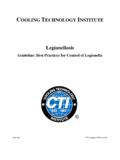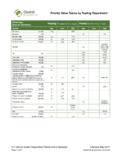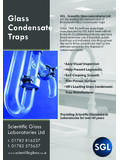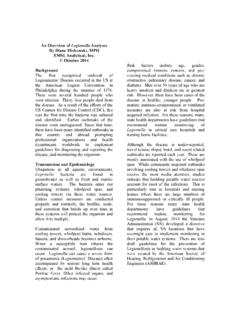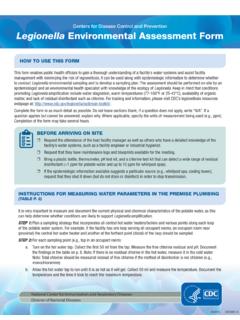Transcription of Legionnaires' disease: A guide for dutyholders …
1 Health and Safety ExecutiveLegionnaires diseaseA brief guide for dutyholdersLegionnaires diseaseA brief guide for dutyholdersPage 1 of 5 This is a web-friendly version of leaflet INDG458, published 04/12 Who is this leaflet for?This leaflet is aimed at employers and people in control of premises, eg landlords, where man-made water systems are used that could be a potential source for legionella bacteria growth. It will help you to understand the health risks associated with legionella . Legionnaires disease: The control of legionella bacteria in water systems1 provides further details about how to manage and control the risks in your system. What is legionnaires disease?Legionellosis is the collective name given to the pneumonia-like illness caused by legionella bacteria. This includes the most serious legionnaires disease, as well as the similar but less serious conditions of Pontiac fever and Lochgoilhead fever.
2 Legionnaires disease is a potentially fatal form of pneumonia and everyone is susceptible to infection. However, some people are at higher risk, including:people over 45 years of age; smokers and heavy drinkers; people suffering from chronic respiratory or kidney disease; and anyone with an impaired immune system. Where are legionella bacteria found?The bacterium legionella pneumophila and related bacteria are common in natural water sources such as rivers, lakes and reservoirs, but usually in low numbers. Since legionella bacteria are widespread in the environment, they may also contaminate and grow in purpose-built water systems such as cooling towers, evaporative condensers, hot and cold water systems and whirlpool there legionella risks in my workplace? Any water system that has the right environmental conditions could potentially be a source for legionella bacteria growth.
3 There is a reasonably foreseeable legionella risk in your water system if:water is stored or re-circulated as part of your system; the water temperature in all or some part of the system is between 20 45 C; there are sources of nutrients such as rust, sludge, scale and organic matters; the conditions are likely to encourage bacteria to multiply; it is possible for water droplets to be produced and, if so, if they can be dispersed over a wide area, eg showers and aerosols from cooling towers; andit is likely that any of your employees, residents, visitors etc are more susceptible to infection due to age, illness, a weakened immune system etc and whether they could be exposed to any contaminated water and Safety ExecutiveLegionnaires disease: A brief guide for dutyholders Page 2 of 5 The most common places where legionella can be found include purpose-built water systems, cooling towers, evaporative condensers, hot and cold water systems and spa pools.
4 There are also a number of other systems that may pose a risk to exposure to legionella , eg humidifiers, air washers, emergency showers, indoor ornamental fountains etc. What are my duties?Under general health and safety law, as an employer or person in control of a premises (eg a landlord), you have health and safety duties and need to take suitable precautions to prevent or control the risk of exposure to legionella . Details of the specific law that applies can be found in part 1 of Legionnaires disease: The control of legionella bacteria in water out a risk assessment is your responsibility and will help you to establish any potential risks and implement measures to either eliminate or control risks. You may be competent to carry out the assessment yourself but, if not, you should ask someone with the necessary skills to conduct a risk assessment.
5 This can be done by someone from within your own organisation or from someone outside, eg an external consultant. How do I identify and assess sources of risk?To identify the risks in your water system you, or a competent person who understands your water systems and any associated equipment, should establish any possible exposure to legionella risks, as listed above, as part of a risk assessment. Your risk assessment should include:management responsibilities, including the name of the competent person and a description of your system;any potential risk sources; any controls currently in place to control risks; monitoring, inspection and maintenance procedures; records of the monitoring results, inspection and checks carried out; and a review date. If you decide that the risks are insignificant and are being properly managed to comply with the law, your assessment is complete.
6 You will not need to take any further action, but it is important to review your assessment periodically in case anything changes in your system. How do I manage the risk? As an employer or person in control of premises, you must appoint someone competent to help you comply with your health and safety duties, eg take responsibility for managing the risks. A competent person is someone with the necessary skills, knowledge and experience to manage health and safety, including the control measures. You could appoint one, or a combination of:yourself; one or more workers; and/or someone from outside your business. Health and Safety ExecutiveLegionnaires disease: A brief guide for dutyholders Page 3 of 5If there are several people responsible for managing your risks, eg because of shift-work patterns, you need to make sure that everyone knows what they are responsible for and how they fit into the overall risk management programme.
7 If you decide to employ contractors to carry out water treatment or other work, it is still the responsibility of the competent person to ensure that the treatment is carried out to the required standards. Remember, before you employ a contractor, you should be satisfied that they can do the work you want to the standard that you require. There are a number of external schemes to help you with this, for example The control of legionellosis: A recommended code of conduct for service do I prevent or control the risk?You should consider whether you can prevent the risk of legionella in the first place by considering the type of water system you need, eg consider whether it is possible to replace a wet cooling tower with a dry air-cooled system. The key point is to design, maintain and operate your water services under conditions that prevent or adequately control the growth of legionella bacteria.
8 You should, as appropriate: ensure that the release of water spray is properly controlled; avoid water temperatures and conditions that favour the growth of legionella and other micro-organisms; ensure water cannot stagnate anywhere in the system by keeping pipe lengths as short as possible or by removing redundant pipework; avoid materials that encourage the growth of legionella . The Water Fittings and Materials Directory3 references fittings, materials, and appliances approved for use on the UK Water Supply System by the Water Regulations Advisory Scheme); keep the system and the water in it clean; and treat water to either kill legionella (and other microorganisms) or limit their ability to grow. If you identify a risk that you are unable to prevent, you must introduce appropriate controls. You should introduce a course of action that will help you to control any risks from legionella by identifying: your system, eg developing a written schematic; who is responsible for carrying out the assessment and managing its implementation;the safe and correct operation of your system; what control methods and other precautions you will be using; and what checks will be carried out to ensure risks are being managed and how records do I need to keep?
9 If you have five or more employees, you have to record any significant findings, including any groups of employees identified by it as being particularly at risk and the steps taken to prevent or control you have less than five employees, you do not need to write anything down, although it is useful to keep a written record of what you have and Safety ExecutiveLegionnaires disease: A brief guide for dutyholders Page 4 of 5 Records should include details about:the person or people responsible for conducting the risk assessment, managing, and implementing the written scheme;any significant findings of the risk assessment; the written control scheme and its implementation; and the results of any inspection, test or check carried out, and the dates. This should include details about the state of operation of the system, ie in use/not in records should be retained throughout the period for which they remain current and for at least two years after that period.
10 Records kept in accordance with the last bullet point above should be retained for at least five years. Do I have any other duties? Under the Notification of Cooling Towers and Evaporative Condensers Regulations 1992,4 you must notify your local authority, in writing, if you have a cooling tower or evaporative condenser on site and include details about where it is located. You must also tell them if/when such devices are no longer in use. Notification forms are available from your local environmental health department. If you have a case of legionellosis in an employee who has worked on cooling towers or hot water systems that are likely to be contaminated with legionella , you must report this under the Reporting of Injuries, Diseases and Dangerous Occurrences Regulations (RIDDOR).5 References1 Legionnaires disease. The control of legionella bacteria in water systems.











